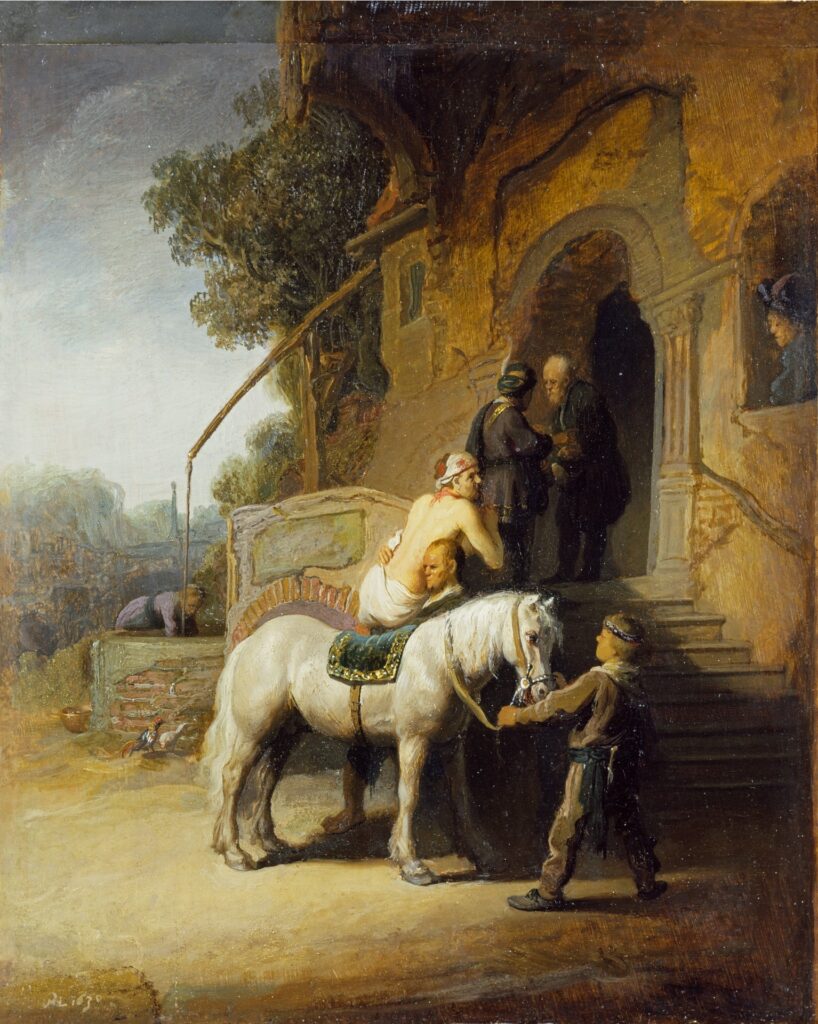A few months after starting his new job in Leipzig in May 1723, Bach’s weekly rhythm of performing a cantata for each Sunday in the Leipzig churches was already well established. Cantata BWV 77 was one of the newly composed pieces that year, for the 13th Sunday after Trinity which fell on August 22. According to the records we have, this cantata was performed just one time and never reused in Bach’s lifetime.
Per the liturgical calendar, for this Sunday Bach was confronted with the task of illustrating the parable of the Good Samaritan (Luke 10: 23-37). He chose a libretto by Johann Oswald Knauer for a 1720 cantata composed in the city of Gotha, to which either Bach himself or an unknown librettist made small (but very meaningful) modifications. Bach composed three cantatas with texts by Knauer in 1723 (BWV 77, 64 and 69a), but scholars are not clear as to how he became acquainted with those librettos.
The scoring for BWV 77 calls for the customary two oboes, strings and basso continuo, with the somewhat unusual addition of a “tromba da tirarsi”, and on the vocal side a four-part choir plus four soloists (soprano, alto, tenor and bass).
The “tromba da tirarsi” is a trumpet fitted with a sliding mechanism similar to the trombone’s, normally used by town pipers to play chorale melodies. Unlike the natural trumpet, which was limited to the notes in one harmonic series, the tromba da tirarsi was able to play additional tones by lengthening or shortening its tube using the slide.
Like many cantatas of this period, the libretto opens with a textual scripture reference (“dictum”), in this case to Luke 10:27. Bach builds a bridge between this text and Matthew 22: 34-40, which has Jesus stating essentially the same quote and adding “All the Law and the Prophets hang on these two commandments.” The movement is built as a chorale fantasia, in which Bach gives Luke’s text to the choir while entrusting the trumpet with the melody for “Dies sind die heil’gen zehn Gebot” (“These are the holy Ten Commandments”), a 1524 chorale by Martin Luther. This same melody is also given to the basso continuo in canon at the fifth and by augmentation (one fifth lower, twice-as-long notes as the trumpet), a compositional device that plays on the notion that “canon” means “law”. The fact that the continuo gets the Ten Commandments reference in long notes as the support for the entire structure is, clearly, not a coincidence, and of such importance that some performers (Rudolf Lutz, for example) choose to reinforce the basso continuo line with the sub-bass register of the contrabassoon. Additional symbolism, a bit more arcane, lies on the fact that the trumpet has exactly 10 entrances throughout the movement, and that the closing note of the basso continuo is 10 measures long! There’s a lot more to this movement – for a very thorough analysis, check out Richard Atkinson’s YouTube video.
After this monumental introduction, the cantata has two recitative / aria pairs. The first one deals with loving God, and the second one with the love for one’s neighbor – with a “plot twist” that gives this cantata quite a unique profile.
The first set of recitative and aria is entrusted to the bass and soprano, respectively. In the bass “secco” recitative, I love how the opening words, “So it must be,” are set very matter-of-factly to a major triad. The soprano aria is a sweet and placid love song, scored with two oboes and continuo, with the oboes moving mostly in thirds to create this pleasant atmosphere. The singing line has word painting devices to underscore some key terms: long melismas for “Herzen” (“heart”) and “erbrennen” (“inflamed”), and, for “ewig” (“eternally”), one that starts with a long, sustained note. This aria contains one of Bach’s modifications to Knauer’s libretto: he substituted “dein Gebot” (“your commandment”) for the original “dieses Glück” (“this happiness”) on the first line of the B section.
The tenor recitative that follows also contains a slight but crucial modification by Bach: the word “zugleich” (“at the same time”) was added, to drive the notion that both commandments are linked and should be fulfilled together. This recitative, in which the tenor asks for a “Samaritan heart”, is a prayer, a fact that is underlined by Bach by setting it as an “accompagnato” with strings.
The text for the alto aria that follows presents a remarkable difference from most cantatas. Usually, the final portion of a cantata libretto changes the mood into a positive outlook, expressing the believer’s hope and trust in God. In this case, the poet remarks on the inability of the listener to fulfill God’s will. This somber realization is illustrated by Bach by scoring the slide trumpet as the obbligato instrument. The baroque trumpet is a notoriously difficult instrument, prone to pitfalls and questionable tuning in performance. Bach writes an extensive, demanding, and exposed trumpet part, full of chromaticism, and sets the aria to a slow, sarabande-like meter with its characteristic accent on the second beat of the measure. In doing so, he lends the aria a sense of unsteadiness and anxiousness that perfectly illustrates the text.
Bach didn’t write the chorale words into his autograph score, so performers and scholars have chosen different texts to fit the music. However, the music by itself drives the interpellating message of the cantata, as it ends with an inconclusive cadence after an uneven 5 phrases, leaving the listeners soul-searching to find the final answer on their own.
